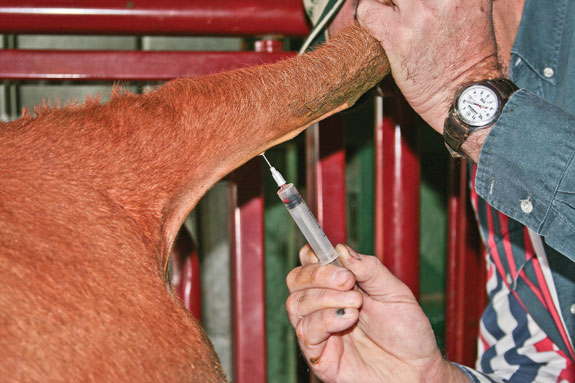And, as grain prices soar, feedlot managers also are looking to maximize gain per dollar of feed. The impact of these conditions weighs heavy on the cattle feeding industry.
“Large numbers of cattle and replacement heifers which, under normal conditions, would be kept, are being sold off this year,” says Teresa Schwertner, noting that many of these females are finding their way into the feedlots.
Teresa and her father, Billy, run several ranches and cattle auction barns based in Wharton, Texas.
Unique management considerations
This increased influx of female cattle going into feedyards means feedlot managers need to be more aware of the pregnancy status of the females.
Typically 3 to 15 percent of yearling heifers entering feedlots are pregnant on arrival, which significantly reduces feedlot performance.
A pregnant heifer has reduced feed efficiency, poorer dressing percentage and greater number of infections due to calving and abortion, leading to increased labor, medicine cost and death loss.
The cost of feeding out a pregnant heifer has been estimated at $44 to $115 greater than a non-pregnant heifer.
There are several options to manage the feedlot pregnancy risk. Two options widely used are palpation for pregnancy diagnosis and/or administering a prophylactic dosage of prostaglandins to all heifers upon arrival.
But there are still pitfalls in using these practices. Feedlot veterinarians are often not extensively experienced in pregnancy checking, increasing the risk of misdiagnosis.
Giving prostaglandin to all heifers adds to overall cost of feeding out each heifer and increases the risk of injection site lesions.
Furthermore, later-term pregnancies may not be impacted by prostaglandin shots and, assuming that they will, can create unexpected and uncontrollable issues with calving heifers in the pens.
Better options
Advanced pregnancy testing technologies have surfaced over the years, allowing earlier testing options and with greater accuracy.
Ultrasound and blood-based pregnancy tests are viable alternatives to palpation and can be applied as early as 26 to 28 days post-breeding.
Heifers confirmed open will be well suited to transition into the feedlot setting. Blood-based pregnancy testing does not require a veterinarian to be on hand as they arrive at the feedyard, though veterinarians can certainly be resources to draw the blood samples.
Blood pregnancy testing can save money by identifying short-bred heifers accurately, which is a benefit that supersedes the need to wait a couple of days for the results.
Test results can be available before females are transitioned into their pen, and pregnancies can therefore be dealt with equally as well as timely and efficiently.
Insights for additional value
Early blood pregnancy detection also can present added-value opportunities. Some cattle enterprises use this technology in an effort to explore additional options for managing heifers that provide greater profitability.
Feeding operations for cull cows employ such tests to identify pregnant females, which enables managers to sell or pasture the pregnant cows and heifers for calving, rather than raising them for slaughter.

Billy Schwertner buys and sells replacement cows and has found blood-based pregnancy testing to be an efficient marketing tool.
“We were palpating all the cows we buy out of the sale barn, then turning the open animals out with bulls to get them bred and selling the bred cows,” explains Schwertner.
“But we were coming up with about 50 percent open cows and 50 percent bred cows. I convinced my partner that we should continue to preg check with palpation, but we should use a blood pregnancy test on the cows that a veterinarian or palpator would call open at the sale barn.”
Schwertner and his partner are now seeing results of 30 to 50 percent more pregnant with easier means to identify those short-bred animals.
With the trying times of the Texas drought, blood pregnancy testing also may help cattlemen in similar situations looking to relieve some of their herds.
“If the cattlemen down here [Texas] have to cull their herds due to the drought – the blood test is better than palpation because they don’t want to let those cows go that may have even a remote chance of having calves in them,” says Teresa Schwertner, who also runs Bio Preg Check, a blood-pregnancy testing lab in Wharton, Texas.
“They are trying to decrease the size of their herds because there is nothing for them to eat, but it’s important to keep those of value. Culling the open cows and keeping the bred females is a smarter strategy.”
How it works
To use blood-based pregnancy testing, a blood sample must be drawn from the heifer into a red-topped blood collection tube.
Once all blood samples have been obtained, they can be shipped or driven to a local lab for laboratory analysis.
Managers will then receive a pregnancy status report within a few hours, or a day, depending on the location of the lab and lab test used. Following receipt of the report, the heifers can be sorted off for special management or induction of abortion.
All heifers should be evaluated for pregnancy upon entering the feedyard. After an evaluation of the resources, labor and costs involved, managers can make an informed decision of what pregnancy management option is best for their operation.
When inclement weather and other outside forces create more pressure for efficiency, focusing on new management technologies can deliver greater results and protect profit margins. ![]()
PHOTOS:
TOP: Blood samples are placed in red-topped blood collection tubes and prepared for proper analysis.
BOTTOM: Blood tests for pregnancy can be a better option than palpation for accuracy in detecting open cows. Photos courtesy of BioTracking

Jeremy Howard
BioTracking LLC
jhoward@biotracking.com







